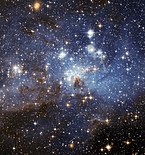Diacetylene (also known as butadiyne) is the organic compound with the formula C4H2. It is the simplest compound containing two triple bonds. It is first in the series of polyynes, which are of theoretical but not of practical interest.
![]()
https://en.wikipedia.org/wiki/Diacetylene
The ethynyl radical (systematically named λ3-ethyne and hydridodicarbon(C—C)) is an organic compound with the chemical formula C≡CH (also written [CCH] or C
2H). It is a simple molecule that does not occur naturally on Earth but is abundant in the interstellar medium. It was first observed by electron spin resonance isolated in a solid argon matrix at liquid helium temperatures in 1963 by Cochran and coworkers at the Johns Hopkins Applied Physics Laboratory.[1] It was first observed in the gas phase by Tucker and coworkers in November 1973 toward the Orion Nebula, using the NRAO 11-meter radio telescope.[2] It has since been detected in a large variety of interstellar environments, including dense molecular clouds, bok globules, star forming regions, the shells around carbon-rich evolved stars, and even in other galaxies.
![]()
Finally, high-spectral-resolution observations of Zeeman splitting in C2H can give information about the magnetic fields in dense clouds, which can augment similar observations that are more commonly done in the simpler cyanide (CN).[7]
Formation and destruction[edit]
The formation and destruction mechanisms of the ethynyl radical vary widely with its environment. The mechanisms listed below represent the current (as of 2008) understanding, but other formation and destruction pathways may be possible, or even dominant, in certain situations.
Formation[edit]
In the laboratory, C2H can be made via photolysis of acetylene (C2H2) or C2HCF3,[8] or in a glow discharge of a mixture of acetylene and helium.[9] In the envelopes of carbon-rich evolved stars, acetylene is created in the thermal equilibrium in the stellar photosphere. Ethynyl is created as a photodissociation product of the acetylene that is ejected (via strong stellar winds) into the outer envelope of these stars. In the cold, dense cores of molecular clouds (prior to star formation) where n > 104 cm−3 and T < 20 K, ethynyl is dominantly formed via an electron recombination with the vinyl radical (C
2H+
3).[10] The neutral-neutral reaction of propynylidyne (C3H) and atomic oxygen also produces ethynyl (and carbon monoxide, CO), though this is typically not a dominant formation mechanism. The dominant creation reactions are listed below.
- C
2H+
3 + e− → C2H + H + H - C
2H+
3 + e− → C2H + H2 - CH3CCH+ + e− → C2H + CH3
- C3H + O → C2H + CO
Destruction[edit]
The destruction of ethynyl is dominantly through neutral-neutral reactions with O2 (producing carbon monoxide and formyl, HCO), or with atomic nitrogen (producing atomic hydrogen and C2N). Ion-neutral reactions can also play a role in the destruction of ethynyl, through reactions with HCO+ and H+
3. The dominant destruction reactions are listed below.
- C2H + O2 → HCO + CO
- C2H + N → C2N + H
- C2H + HCO+ → C
2H+
2 + CO - C2H + H+
3 → C
2H+
2 + H2
https://en.wikipedia.org/wiki/Ethynyl_radical
In astronomy, Bok globules are isolated and relatively small dark nebulae, containing dense cosmic dust and gas from which star formation may take place. Bok globules are found within H II regions, and typically have a mass of about 2[1] to 50 solar masses contained within a region about a light year or so across (about 4.5×1047 m3).[2] They contain molecular hydrogen (H2), carbon oxides and helium, and around 1% (by mass) silicate dust. Bok globules most commonly result in the formation of double- or multiple-star systems.[3]

https://en.wikipedia.org/wiki/Bok_globule
No comments:
Post a Comment